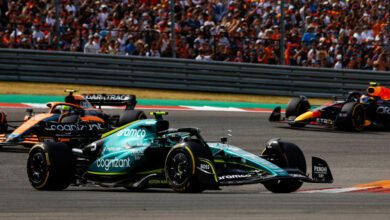Brundle’s Bold Stance on Extreme Weather in F1: A Test of True Heroism or a Safety Risk?
Martin Brundle, the former Formula 1 driver, recently defended the inclusion of extreme weather races in F1, citing them as a testament to the heroism and athleticism of drivers. His comments come amidst growing safety concerns following the challenging conditions at the Qatar Grand Prix.
Key Takeaways:
- Brundle’s Firm Stance: Martin Brundle expressed his views on social media, opposing the idea of avoiding races in extreme conditions, such as the intense heat experienced during the Qatar Grand Prix. He emphasized the importance of these challenges in showcasing the drivers’ heroism and skill.
- Impact on Drivers: The Qatar Grand Prix’s extreme heat, reaching 34 degrees Celsius, significantly impacted the drivers, leading to cases of dehydration and exhaustion. Notable incidents included Logan Sargeant’s mid-race retirement and post-race exhaustion of Max Verstappen and Oscar Piastri.
- Safety Concerns vs. Racing Spirit: While Brundle highlights the essence of F1 racing in overcoming tough conditions, the health and safety risks to drivers, evidenced by incidents like Esteban Ocon’s sickness and Fernando Alonso’s semi-burn, raise serious questions about balancing the spirit of racing with the well-being of participants.

In a recent social media statement, Martin Brundle, a revered figure in the Formula 1 community, has boldly defended the continuation of extreme weather races in the sport. Amidst escalating debates about driver safety, particularly following the physically taxing Qatar Grand Prix, Brundle’s words carry significant weight.
Sunday’s race in Qatar was a testament to the harsh conditions drivers sometimes face. With temperatures soaring to 34 degrees Celsius, the challenge was not just about speed and strategy but also about physical endurance. Williams driver Logan Sargeant’s retirement due to the unbearable conditions highlighted the severity of the situation. Even seasoned drivers like Max Verstappen and Oscar Piastri were visibly drained post-race, underlining the brutal impact of the extreme heat.
Despite these evident hardships, Brundle remains unswayed in his view that such challenges are integral to Formula 1. He believes that it’s precisely these extreme conditions that elevate the status of F1 drivers, showcasing their exceptional capabilities and resilience. Brundle’s unaltered quote on social media strongly encapsulates this sentiment:
“It’s races like Qatar and very rainy days which make F1 drivers look the heroes and athletes they are.
“Absolutely don’t buy into the weak view we shouldn’t put them through this kind of challenge.
“Check out Senna in Brazil, Stewart at rainy Nurburgring, Lauda post crash, etc etc”
However, there’s an undeniable concern for the drivers’ well-being. The Qatar Grand Prix wasn’t an isolated case of a few individuals struggling; numerous drivers faced health issues directly related to the extreme conditions. For instance, Esteban Ocon experienced sickness during the race, and Fernando Alonso suffered a semi-burn, pointing towards a broader issue of safety under such harsh circumstances.
Brundle’s point about the historical heroism of drivers in adverse conditions stands. Drivers like Senna, Stewart, and Lauda have indeed become legends in part due to their triumphs in extreme scenarios. However, the evolving discourse on health and safety in sports suggests that perhaps a new balance needs to be struck. While acknowledging Brundle’s perspective on the essence of F1 racing, it’s imperative that the sport continues to evolve its safety measures to ensure that the drivers’ heroism doesn’t come at the cost of their health and well-being.


